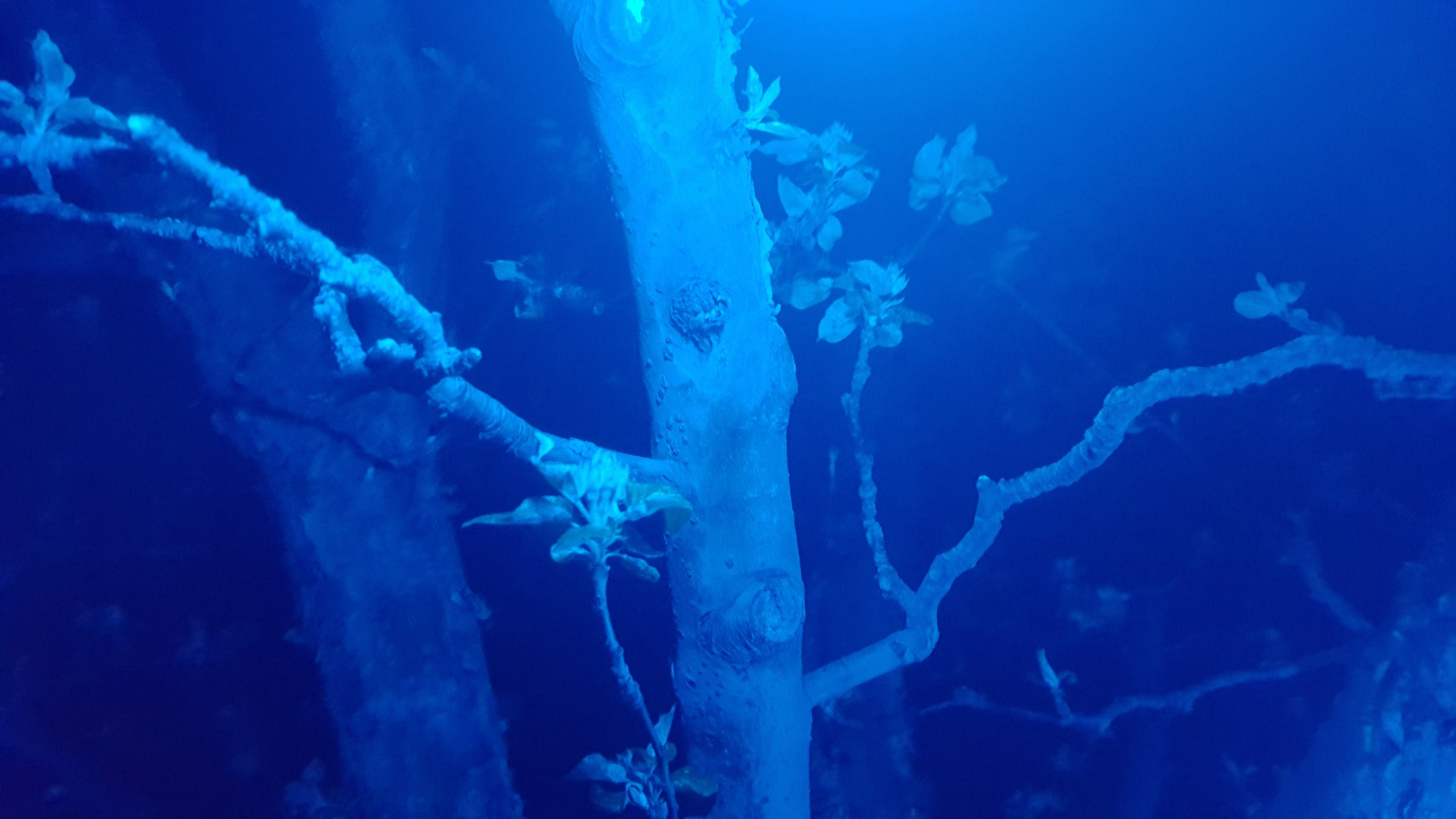Observing the orchard by blacklight
We are always observing and learning new things on the orchard, even when we aren’t able to devote time to carrying out substantial research projects. In this post, I’m going to share four observations made while exploring the orchard at night using the glow of a UV flashlight, as well as some of the questions these observations raise.
The four observations relate to (1) orb-weavers, (2) visualizing fertilizer spread, (3) signs of tree stress in bark, and (4) bloom differentiation.
1. Orb-weavers
Araneus diadematus reconstructing a web. When an orb weaver finds a good spot for a web, they will remain there unless seriously disturbed, rebuilding the web each night. The longest I have tracked one single spider living in the same location is just short of six weeks.
Spider web silk is reflective and easy to spot by blacklight. Many orb-weavers also concentrate guanine crystals (a product of protein metabolism) under their exoskeleton, giving them characteristic white markings that reflect UV light. When I started observing the orchard at night in the spring of 2020, I did so because I was interested in learning more about spiders.
Spiders are incredibly important beings on our orchard. Ecologically, they are carnivorous predators that do the important work of making sure that no species of arthropod ever becomes too abundant. There can never be too many of them on the orchard because they are cannibalistic and therefore, self-limiting.
By observing spiders at night, we have been able to learn a lot about how and where the orb-weavers on our orchard like to live. This knowledge helps us to promote their favoured habitats and minimize disturbance to their lives, so we can better coexist.
2. Visualizing fertilizer spread
A low-quality image of feathermeal illuminated by blacklight. The feathermeal has just been watered in over an 8-hour irrigation period.
Feathermeal is a relatively slow-release, high nitrogen fertilizer that can be used in organic orchards in place of conventional fertilizer. It consists entirely of sterilized, dried, ground-up feathers, and is a recycled waste product from the poultry industry.
In spring 2022, we applied feathermeal to the soil under our orchard trees in order to address a nitrogen deficiency in our soil. We applied the feathermeal by hand, using calibrated measuring cups and a swinging arm motion to distribute the fertilizer as evenly as possible under the dripline of trees.
Because feathermeal is dark brown and consists of grains smaller than rice, it is not easy to tell, by the light of day, whether you’re spreading it evenly. Luckily, and to our surprise, feathermeal glows in the dark! The photograph above was taken right after feathermeal was watered into the soil. Though the photograph does not do reality justice, you can kind of see how the feathermeal grains have turned into a sticky, distributed mat of gunk that is easily illuminated by UV light.
The fact that feathermeal reflects UV light means that you can use a blacklight to test how well your fertilizer spreading technique is working (note: ideally, you’ll carry out a small test at night before you spread your fertilizer over a large area). While you’re at it, you might want to see whether blacklight visualization works with other kinds of fertilizers as well.
3. Signs of tree stress in bark
This tree is illuminated by a podpoi v2, not technically a blacklight, though some UV reflection is apparent with this light also. I don’t have any good pictures of bark by blacklight - you’ll have to go out and study what it looks like yourself!
Many types of wood are at least slightly fluorescent. I have noticed that the texture and colour of apple wood varies quite a bit under blacklight.
One particularly interesting observation about bark fluorescence is that it seems to change when the trees are undergoing stress. I first noticed this in the spring of 2021, when the trees were undergoing drought stress due to lack of rain before the irrigation was turned on by the District of Summerland. The bark of our gala trees, in particular, looked different than usual. The fluorescence of the bark had a spongier texture or something. Hard to explain.
I wonder whether fluorescence could turn out to be a useful diagnostic tool for tree health.
4. Bloom differentiation
While not apparent in the photograph above, the stamens of the king bloom are fluorescent orange under blacklight, while the stamens of the side blooms are fluorescent yellow.
A fourth area where I’ve noticed an interesting colour difference under blacklight is within apple bloom clusters. After petal fall, the stamens of the king bloom (the bloom in the middle of the cluster) are the colour of a fluorescent orange highlighter, while the stamens of the side blooms are the colour of a standard yellow highlighter.
I am not sure what the significance of this colour difference is, but it is a difference that bees and other winged pollinators probably make use of. The orangeyness of the king bloom could come about simply because king blooms mature earlier than side blooms. Or, since king blooms usually receive more pollination than side blooms, the colour difference could signal different levels of pollination. If the latter were the case, colour could be used to measure (relative) levels of pollination in the orchard.
If anyone has any information related to the topics and questions raised here, contact us! We’d love to learn more.
By Katie Sardinha



